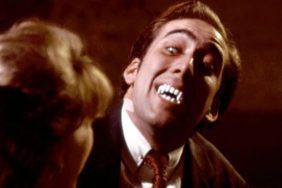Welcome back to The Series Project, CraveOnline‘s series devoted to watching every sequel ever made. The next three weeks will be devoted to an important chapter in horror film history: The Hammer Dracula films.
If you are unfamiliar with England’s famed Hammer studios, pull up a stool and plunk yourself down. Lemme learn you a thing or two. As I once, long ago, iterated in a CraveOnline review of The Hammer Vault (a coffee table book all about said studio) the British movie company was in operation from 1954 until 1979, churning out almost 80 films in that 25-year period, most of them well-regarded and very lurid – but not always good – horror movies. The early films’ gore and sex are tame by today’s standards, but the heaving bosoms and bloodied lips therein were enough to shock audiences of the mid 1950s, and Hammer gained a reputation for pushing to envelope.
Hammer’s films were always schlocky, but they didn’t have the same sleazy Eurotrash feeling of, say, the Italian horror films of the same era. Hammer films were just as lurid in terms of content (well, maybe there were fewer lesbian vampire films), having gore, blood, sex, and monsters in almost all of their movies, but were possessed of a Gothic classiness that harkened more toward the glorious American Universal Monster movies of thirty years previous.
Hammer made its first Universal-inspired horror movie in 1957 with The Curse of Frankenstein, directed by Terence Fisher, the master of the studio, and a name you ought to know. Curse proved to be such a big hit that Mummies and Draculas were plundered soon thereafter. The first Dracula movie Hammer made was 1958’s Horror of Dracula. It is here that I will start off. If you are unfamiliar with Hammer Studios, then consider this Series Project a primer on the studios importance, and what kinds of movies they made. Hammer has recently re-opened its doors, making films like Let Me In and The Woman in Black.
There were nine films in the Hammer Dracula cycle, stretching from 1958 until 1974. All of the films feature either Christopher Lee as the title monster, or Peter Cushing as Dr. Van Helsing. This week, I’ll talk about Horror of Dracula, The Brides of Dracula, and Dracula: Prince of Darkness. The more interesting titles (Taste the Blood of Dracula) will wait until future weeks.
To begin…
Horror of Dracula (dir. Terence Fisher, 1958)

Many modern horror fanatics have openly declared their dislike and distaste for Tod Browning’s famous 1931 film version of Dracula. The central complaint is that the quiet film (there is hardly any music) feels stagey and far too mannered for its own good. I personally like the stiff theatricality of the 1931 film, as it lends an earnest and creepy live-theater grand guignol flavor to the proceedings; yes, I think Dracula is actually scary.
Hammer’s Horror of Dracula, possessed of a similar stagey-ness, may be far more accessible to those same audiences. Shot in glorious ’50s Technicolor (and I adore that cinematic look), Horror of Dracula retells the familiar Dracula story, but with a brisk pace and a few more shocking visuals. Plus, it benefits greatly from the presence of Christopher Lee as Dracula and Peter Cushing as Van Helsing.
As a Dracula, Christopher Lee is an imposing presence. Lee, standing 6’5”, towers over his costars with a stentorian authority. His voice is deep and commanding. Previous Draculas were either hideous diseased ghouls who lived in shadows (as in Nosferatu), or erudite and untouchable Slavic seducers (as with Bela Lugosi). Lee was the first Dracula who looked like he could physically overpower you. He wasn’t just a suave blood-drinking aristocrat, he was a stallion. I know few people who have had burning crushes on Christopher Lee, but watching him in Horror of Dracula, I do get the sense of his power and potency. This is not a shrinking violet, this Dracula. This is a man who can – and will – take what he wants. Lee’s very presence turns this Dracula into perhaps a less “scary” but much more threatening monster than we’ve had in the past.

Even better, though, is the presence of Peter Cushing as Dr. Van Helsing. Van Helsing has previously been kind of an obscure character, a chattering expert whose only function in the story is to provide exposition on the monster, and provide the hero the means to do the actual killing. In Horror of Dracula, Cushing turns Van Helsing into a man of action, a man of faith, and a man of science. He is collected, intelligence pouring off of him, even when he’s not saying anything. He’s like a cross between Mr. Spock and Indiana Jones, careful to analyze, but quick to act when trouble is brewing.
Indeed, when Van Helsing must finally do battle with Dracula in all of the Hammer Dracula movies, he doesn’t have to sneak about or force his way through anything. He bounds across tabletops and swings on ropes, ready to evade and destroy. He is not about flash. He gets the job done. I really, really like Van Helsing in these movies.

I’m not sure if I have to recount the story. It is altered slightly from the Bram Stoker original, but not by much. Jonathan Harker (John Van Eyssen) visits Dracula (Lee), and is bitten, and eventually dies (change #1). Dracula somehow makes his way back to England (or perhaps it’s a nearby town) where he immediately begins feeding on Jonathan’s betrothed Lucy (Carol Marsh, who should have rightfully been Mina, change #2). Dr. Van Helsing is called in to investigate, and knows immediately that it is a vampire. He instructs people to keep the windows shut in case of bats, and to hang garlic, etc. etc.
A few things that were set up in this film that will continue throughout the Hammer Dracula cycle. In every film Dracula (or the vampire at the center) has at least two female vampire slaves. The two slaves tend to gad about in white diaphanous robes. Dracula strangles men with his bare hands. I suppose it’s his preferred mode of murder. The end of the second act will always feature a big confrontation wherein the vampire reveals himself. There’s a lot of bounding! There are also a lot of “slow screams;” That is: someone will see the vampire, and their reaction will be to recoil back, drop their jaw slowly, bug their eyes out, and only let out a scream after about five or six seconds.

Eventually Van Helsing pins Dracula to the ground with a cross, and, in a wonder of special effects, Dracula is burned away by sunlight. It’s a spectacular end to a classic movie. The films will improve in terms of quality and pacing, but the look and tone of Horror of Dracula is perhaps more important to cinema history. See this one, even if you don’t watch the others.
Also, Michael Gough appears. He’s like William Hickey or Peter Falk. Is there a time when that guy was young?








